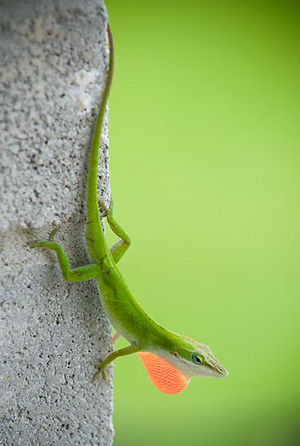Green Anole
| This article has been peer reviewed but is awaiting expert review. If you would like to help with this, please see more information about expert reviewing. |
Scientific name: Anolis carolinensis
Description
Diurnal and semi-arboreal. The total length of adults will range from 13-20 cm, although some males may exceed this. Green anoles are slender lizards with long tails (fragile and readily lost) and a pointed head. They have a toe development, which enables them to climb smooth vertical surfaces. The general colour is brown to green depending on mood and temperature. Anoles will change colour to thermoregulate - darker when cold and lighter when warm. The underside is generally lighter-coloured. Males are larger than females and have a pink dewlap, which they use to display to females and rivals. Females and juveniles of both sexes may have a white middorsal line (most males lack this).
Green anoles, if maintained properly, will grow from hatchling (5-6 cm) to small adult size in 6-8 months and have a typical lifespan of 3-6 years.
Range
The green anole is found in south-eastern USA, Cuba, Jamaica, and other Caribbean islands. Its habitat includes bushes, trees, rock walls, woods and around houses. Only the green anole is native to the USA; all other anoles are released or escaped pets, many of which have survived and bred. There are over 36 species of non-native anoles breeding in the wild in Florida - out of an estimated 250 anole species in the world. The vast majority of green anoles sold in the pet trade have been wild caught in the south-eastern U.S. There has been considerable interbreeding with introduced species so markings may be considerably altered from the true wild types.
Diet
Wild diet includes grubs, crickets, cockroaches, spiders, moths, and other arthropods.
The most recommended food for green anoles is two to three week old nutrient loaded crickets. Five to six week old crickets are too large (as with many reptiles, anoles may be scared of prey that is too large for them to handle; the size of prey items fed to them should be no bigger than 1/2 the size of the anoles head). Small mealworms and just moulted "white" mealworms can be offered occasionally. Small waxworms (Galleria mellonella) and flies can be offered for variety. Beetles should be avoided.
On an optimal feeding schedule, green anoles should be offered food every other day. Usually two to three food items are sufficient.
Supplementation is necessary.
Enclosure
The minimum requirement set-up for one to two anoles is a 50 litre all-glass tank with a screen top, a specific UV light source with a photoperiod of 12-14 hours a day, a basking light 40W bulb or lower wattage, subtank heating pad, and three thermometers (cool end, warm end and basking area). Sterile peat moss or potting soil over a one inch layer of pea grave or 2.5-5 cm of potting soil covered with bark mulch serves as the ideal substrate. Several 5 cm potted plants help to maintain humidity and provide cover and shade from the UV and basking lights. Sansevierias are good, as are bromiliads, philodendrons, ivies, orchids, vines and groundcovers. Pothos vine (Scindapsus aureus) can be included.
Anoles are semi-arboreal requiring suitable climbing materials. Logs or branches with diameters equal to or slightly greater then the width of the lizards are ideal. Thin pieces of cork bark placed diagonally across the vivarium will also work well.
Hot rocks, heat tapes, heated caves, water bowls, sand or gravel substrates are not appropriate for anoles.
Humidity should be maintained around 60-70%. Ventilation should be adequate to prevent excessive humidity. Lightly spray the enclosure and plants with purified water several times a day. The anoles lap droplets from leaves and the glass sides of the vivarium - they do not readily drink from bowls containing still water.
As a general rule, keep anoles either singly or in groups consisting of one male and one or more females.
Temperature
For green anoles, daytime air temperatures in the vivarium should be 23-29ºC. The temperature at basking sites should be up to 34ºC. At night, the temperature can drop to 18ºC. For tropical anoles the temperature should not drop below 22ºC.
Literature Search
Use these links to find recent scientific publications via CAB Abstracts (log in required unless accessing from a subscribing organisation).
Green Anole (Anolis carolinensis) publications

